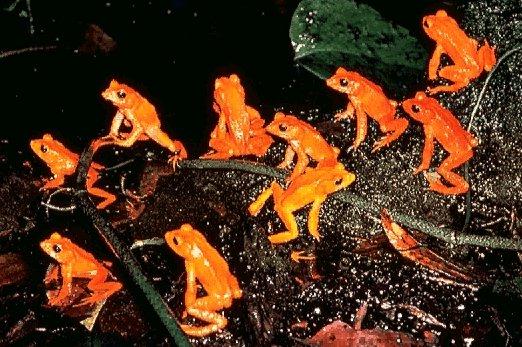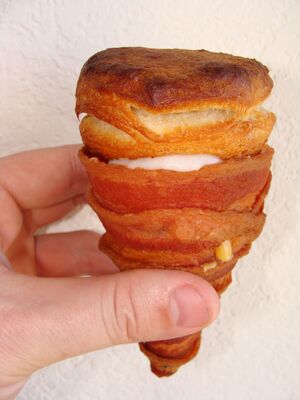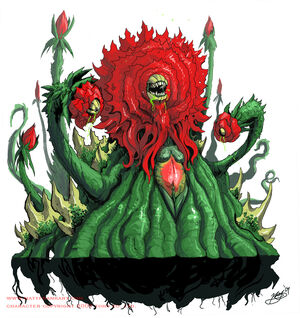Imagine, for a minute, that you're a poor farmer in Chile. You have a nice little chicken coop outside your house that provides meat and eggs for your whole family, along with some surplus to share with the neighbors. Sure, you may not be the richest people in your town, but you do know where your food's coming from.
Then, one morning, your rooster doesn't crow. Wondering exactly what is going on with that lazy bird, you take a walk over to the chicken coop...only to find every single chicken dead on the ground. The bizarre thing? They have been completely drained of blood with only two circular wounds to show for it. Looks like Dracula's switched to white meat for some reason.
Well, Dracula or the creature above. That ugly mug belongs to el chupacabras, AKA the "goatsucker" or just "chupacabra." The name is a little bit misleading; although termed "goatsucker," most forms of livestock are fair game, goats and sheep included. It is said to range from Florida and Texas all the way down into Chile; hell, some would even say Maine has a chupacabra. Let us refresh your memory for a second: Maine is where every Stephen King novel ever takes place.
Part of the ambiguity of its range comes from the various descriptions of a chupacabra. The 'original' chupacabra was described as a half-human vampiric creature in the 1950's. This slowly evolved into not one, but two bestial forms: One is a sort of anthropomorphic, spiny lizard about a meter tall with red glowing eyes (literally straight out of Species) and the other is a hairless hellhound with a pronounced spine and, again, glowing eyes. Both are creatures that we would not want to encounter in a dark alley...or in our chicken coops!
The main unifying factor of a 'chupacabra' remains that, whatever it is, its calling card is leaving vampire marks on dead livestock.There are debates over whether the victims are completely drained of blood or not, but the two marks are always an indicator of a chupacabra as opposed to anything else. As long as nobody designs a chupacabra that sparkles, we have reason to believe that those marks are as similar to vampires as they get.
As with, oh, every cryptid this week except the big cats, chupacabras are one of those things that we are unsure of the existence of. We have caught numerous mutant or ill coyotes and dogs that are sometimes called "chupacabras." No word yet on the lizard-like creature. There have also been several fake chupacabras as seen in the initial mugshot.
Although the chupacabra does not receive as good of press as Nessie, it still remains one of the more popular cryptids. There have been several chupacabra movies, including titles such as Scooby-Doo and The Monster of Mexico and Chupacabra: Dark Seas. Monster-of-the-Week series love the chupacabra. Invader Zim's "paranormal investigator" Dib mentioned a chupacabra at one point ("but there's not a goat to feed on for miles"). The Jackie Chan Adventures chupacabra really takes the cake, combining the vampiric creature with some aspects of a werewolf. Neat way to avoid capture, goatsucker.
Then, one morning, your rooster doesn't crow. Wondering exactly what is going on with that lazy bird, you take a walk over to the chicken coop...only to find every single chicken dead on the ground. The bizarre thing? They have been completely drained of blood with only two circular wounds to show for it. Looks like Dracula's switched to white meat for some reason.
 |
| Image belongs to the internet. I have no idea who did this one first. |
Well, Dracula or the creature above. That ugly mug belongs to el chupacabras, AKA the "goatsucker" or just "chupacabra." The name is a little bit misleading; although termed "goatsucker," most forms of livestock are fair game, goats and sheep included. It is said to range from Florida and Texas all the way down into Chile; hell, some would even say Maine has a chupacabra. Let us refresh your memory for a second: Maine is where every Stephen King novel ever takes place.
Part of the ambiguity of its range comes from the various descriptions of a chupacabra. The 'original' chupacabra was described as a half-human vampiric creature in the 1950's. This slowly evolved into not one, but two bestial forms: One is a sort of anthropomorphic, spiny lizard about a meter tall with red glowing eyes (literally straight out of Species) and the other is a hairless hellhound with a pronounced spine and, again, glowing eyes. Both are creatures that we would not want to encounter in a dark alley...or in our chicken coops!
The main unifying factor of a 'chupacabra' remains that, whatever it is, its calling card is leaving vampire marks on dead livestock.There are debates over whether the victims are completely drained of blood or not, but the two marks are always an indicator of a chupacabra as opposed to anything else. As long as nobody designs a chupacabra that sparkles, we have reason to believe that those marks are as similar to vampires as they get.
 |
| I've seen Chinese Cresteds that looked more like chupacabras..Pic belongs to NewsOne. |
As with, oh, every cryptid this week except the big cats, chupacabras are one of those things that we are unsure of the existence of. We have caught numerous mutant or ill coyotes and dogs that are sometimes called "chupacabras." No word yet on the lizard-like creature. There have also been several fake chupacabras as seen in the initial mugshot.
 |
| Yes, that's Jackie Chan getting thrashed by a chupacabra-luchador. |
Although the chupacabra does not receive as good of press as Nessie, it still remains one of the more popular cryptids. There have been several chupacabra movies, including titles such as Scooby-Doo and The Monster of Mexico and Chupacabra: Dark Seas. Monster-of-the-Week series love the chupacabra. Invader Zim's "paranormal investigator" Dib mentioned a chupacabra at one point ("but there's not a goat to feed on for miles"). The Jackie Chan Adventures chupacabra really takes the cake, combining the vampiric creature with some aspects of a werewolf. Neat way to avoid capture, goatsucker.


















































